load capacity AUDI S8 2009 User Guide
[x] Cancel search | Manufacturer: AUDI, Model Year: 2009, Model line: S8, Model: AUDI S8 2009Pages: 408, PDF Size: 91.63 MB
Page 337 of 408

Tires and wheels -
----------------
•
0 Note
Driving without valve stem caps can cause damage to the tire
valves. To prevent this, always make sure that factory installed valve
stem caps on all wheels are securely mounted on the valve .
W For the sake of the environment
Underinflated tires will also increase the fuel consumption. •
Tires and vehicle load limits
There are limits to the amount of load or weight that any vehicle and
any tire can carry . A vehicle that is overloaded will not handle well
and is more difficult to stop. Overloading can not only lead to loss
of vehicle control, but can also damage important parts of the
vehicle and can lead to sudden tire failure, including a blowout and
sudden deflation that can cause the vehicle to crash.
Your safety and that of your passengers also depends on making
sure that load limits are not exceeded. Vehicle load includes every
body and everything in and on the vehicle. These load limits are
technically referred to as the vehicle's
Gross Vehicle Weight Rating
("GVWR"l.
The "GVWR" includes the weight of the basic vehicle, all factory
installed accessories, a full tank of fuel, oil , coolant and other fluids
plus maximum load. The maximum load includes the number of
passengers that the vehicle is intended to carry ("seating capacity")
with an assumed weight of 150 lbs (68 kg) for each passenger at a
designated seating position and the total weight of any luggage in
the vehicle. If you tow a trailer, the weight of the trailer hitch and the
tongue weight of the loaded trailer must be included as part of the
vehicle load.
The
Gross Axle Weight Rating ("GAWR"l is the maximum load that
can be applied at each of the vehicle's two axles. The
Gross Vehicle Weight Rating and the Gross Axle Weight Rating
are listed on the safety compliance sticker label located either on
the driver's side 8-pillar or on the inside of the fuel filler flap. Your
Audi has 5 seating positions, 2 in the front and 3 in the rear for total
seating capacity of 5. Vehicles with power individual rear seats*
have 4 seating positions, 2 in the front and 2 in the rear for total
seating capacity of 4. Each seating position has a safety belt
~ page 211, "Safety belts".
The fact that there is an upper limit to your vehicle's Gross Vehicle
Weight Rating means that the total weight of whatever is being
carried in the vehicle (including the weight of a trailer hitch and the
tongue weight of the loaded trailer) is limited. The more passengers
in the vehicle or passengers who are heavier than the standard
weights assumed mean that less weight can be carried as luggage.
The tire pressure label on your Audi also lists the maximum
combined weight of all of the occupants and luggage or other cargo
that the vehicle can carry. For the location of the label
~ page 330,
fig. 274.
& WARNING
Overloading a vehicle can cause loss of vehicle control, a crash or
other accident, serious personal injury, and even death.
• Carrying more weight than your vehicle was designed to carry
will prevent the vehicle from handling properly and increase the
risk of the loss of vehicle control.
• The brakes on a vehicle that has been overloaded may not be
able to stop the vehicle within a safe distance.
• Tires on a vehicle that has been overloaded can fail suddenly,
including a blowout and sudden deflation, causing loss of control
and a crash.
• Always make sure that the total load being transported -
including the weight of a trailer hitch and the tongue weight of a
loaded trailer -does not make the vehicle heavier than the
vehicle's Gross Vehicle Weight Rating. •
Vehicle care
I t •
Page 338 of 408
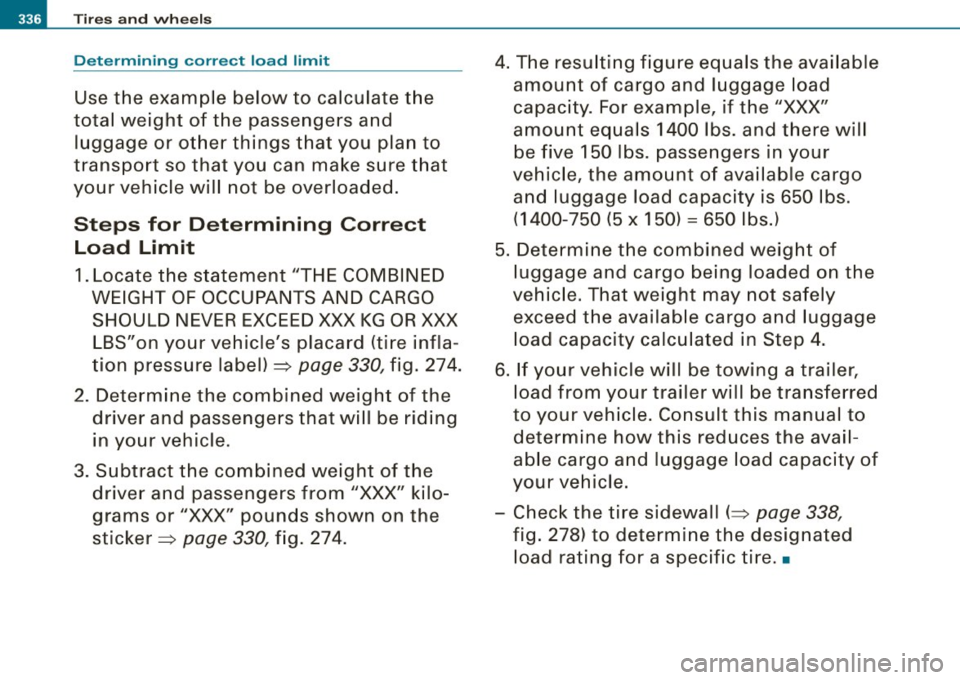
-Tires and wheels
Determining correct load limit
Use the example below to calculate the
total weight of the passengers and
luggage or other things that you plan to
transport so that you can make sure that
your vehicle will not be overloaded.
Steps for Determining Correct
Load Limit
1. Locate the statement "THE COMBINED
WEIGHT OF OCCUPANTS AND CARGO
SHOULD NEVER EXCEED XXX KG OR XXX
LBS"on your vehicle's placard (tire infla
tion pressure label)=> page 330, fig. 274.
2. Determine the combined weight of the driver and passengers that will be riding
in your vehicle.
3. Subtract the combined weight of the driver and passengers from "XXX" kilo
grams or "XXX" pounds shown on the
sticker=> page
330, fig. 274. 4. The resulting figure equals the available
amount of cargo and luggage load
capacity. For example, if the "XXX"
amount equals 1400 lbs. and there will be five 150 lbs. passengers in your
vehicle, the amount of available cargo
and luggage load capacity is 650 lbs.
(1400-750 (5
X 150) = 650 lbs.)
5. Determine the combined weight of luggage and cargo being loaded on the
vehicle. That weight may not safely
exceed the available cargo and luggage
load capacity calculated in Step 4.
6. If your vehicle will be towing a trailer,
load from your trailer will be transferred
to your vehicle. Consult this manual to
determine how this reduces the avail
able cargo and luggage load capacity of
your vehicle.
- Check the tire sidewall (=> page
338,
fig. 278) to determine the designated
load rating for a specific tire. •
Page 379 of 408
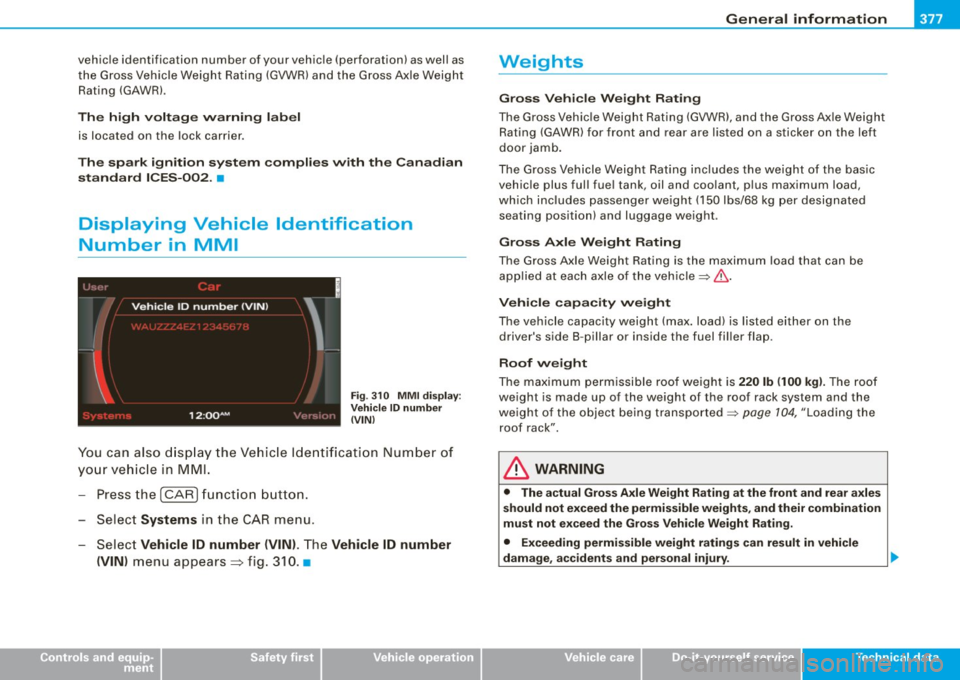
_________________________________________________ G_ e_ n_ e_r _a _l_ i_n _f_o _ r_ m_ a_ t _i _o _ n __ PII
vehicle identification number of your vehicle (perforation) as well as
the Gross Vehicle Weight Rating (GVWR) and the Gross Axle Weight
Rating (GAWRl.
The high voltage warning label is located on the lock carrier.
The spark ignition system complies with the Canadian standard ICES-002. •
Displaying Vehicle Identification
Number in MMI
Fig. 310 MMI display:
Vehicle ID number
(VIN)
You can also display the Vehicle Identification Number of
your vehicle in MMI.
- Press the
(CARI function button.
- Select Systems in the CAR menu.
- Select Vehicle ID number (VIN). The Vehicle ID number
(VIN) menu appears ~ fig. 310. •
Controls and equip
ment Safety first Vehicle operation
Weights
Gross Vehicle Weight Rating
The Gross Vehicle Weight Rating (GVWR), and the Gross Axle Weight
Rating (GAWR) for front and rear are listed on a sticker on the left
door jamb.
The Gross Vehicle Weight Rating includes the weight of the basic
vehicle plus full fuel tank, oil and coolant, plus maximum load,
which includes passenger weight (150 lbs/68 kg per designated
seating position) and luggage w eight .
Gross Axle Weight Rating
The Gross Axle Weight Rating is the maximum load that can be
applied at each axle of the vehicle~& .
Vehicle capacity weight
The vehicle capacity weight (max. load) is listed either on the
driver's side B -pillar or inside the fuel fill er flap .
Roof weight
The maximum permissible roof weight is 220 lb (100 kg). The roof
weight is made up of the weight of the roof rack system and the
weight of the object being transported~ page 104, "Loading the
roof rack".
& WARNING
• The actual Gross Axle Weight Rating at the front and rear axles
should not exceed the permissible weights, and their combination
must not exceed the Gross Vehicle Weight Rating.
• Exceeding permissible weight ratings can result in vehicle
damage, accidents and personal injury.
Vehicle care Do-it-yourself service Tec hn ica l da ta
Page 380 of 408
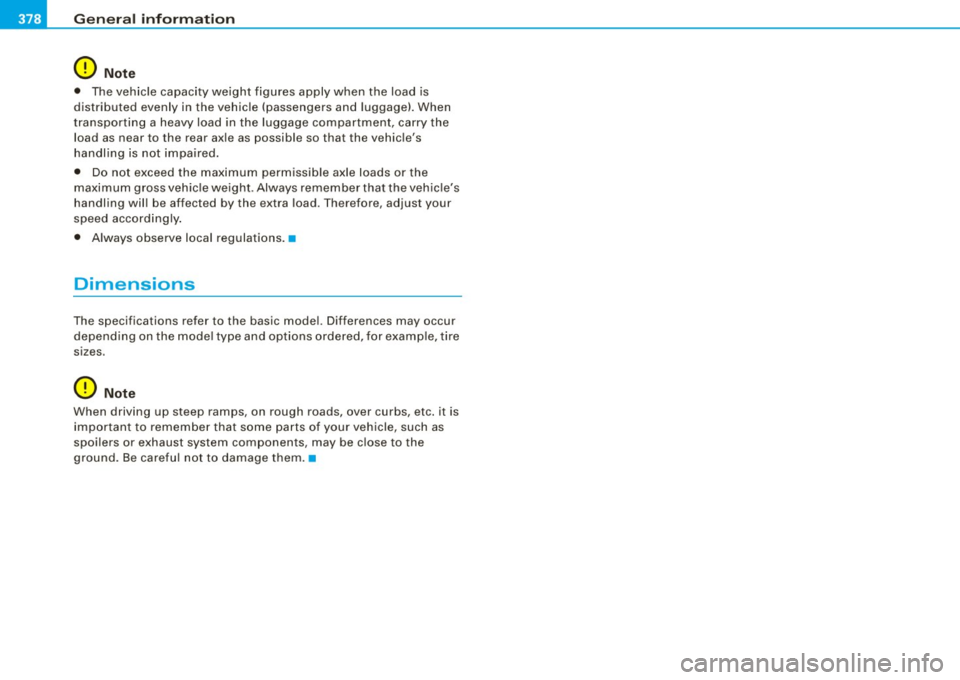
lllffl __ G_ e_n_ e_ r_ a _l _i_n _f _o _ r_ m_ a_ t_ i_ o _ n ________________________________________________ _
0 Note
• The vehicle capacity weight figures apply when the load is
distributed evenly in the vehicle (passengers and luggage). When
transporting a heavy load in the luggage compartment, carry the
load as near to the rear axle as possible so that the vehicle's
handling is not impaired.
• Do not exceed the maximum permissible axle loads or the
maximum gross vehic le weight. Always remember that the vehic le's
handling will be affected by the extra load. Therefore, adjust your
speed accordingly .
• Always observe local regulations. •
Dimensions
The specifications refer to the basic model. Differences may occur
depending on the mode l type and options ordered, for example, tire
sizes.
0 Note
When driving up steep ramps, on rough roads, over curbs, etc. it is
important to remember that some parts of your vehicle, such as
spoilers or exhaust system components, may be close to the
ground. Be careful not to damage them. •
Page 382 of 408

___ D_ a_t _a ________________________________________________________ _
Data
Applies to vehi cle s: wi th 8 -cy lin der eng ine a nd all whee l dri ve
350 hp, a-cylinder engine, with all wheel drive
Engin e data
Maximum output SAE net
Maximum torque SAE net
No. of cy linders
Dis placement
Stroke
Bore
Compression ratio
Fuel
D im ensi on s (ap prox.)
Length (with licence plate bracket)
Width (across mirrors) Height (unloaded)
Turning circle diameter (curb to curb)
Ca pacitie s (a pprox.)
Fuel t ank
-Total capacity
- Reserve (of total capacity)
Wind shield and h eadlight washer fluid cont aine r
Engine oil
with filter change hp@rpm
lb
-ft@ rpm
CID (cm
3 )
in (mm)
in (mm)
350@6800
325@3500
8 cylinder
254 (4163)
3.65 (92.8)
3 .33 (84.5)
12.5: 1
Premium unleaded (91 AKI) Recommended for maximum engine performance . Fur
ther details =:>
page 303, "Gasoline"
in (mm)
in (mm)
in (mm)
ft. (ml
A8 = 199.3 (5062)
A8 = 79 .8 (2028)
A8 = 56.9 (1444)
A8 = 41.0 (12.5)
gal (liters)
gal (liters)
quarts (liters)
quarts (liters)
A8 L = 204 .4 (5192)
A8 L = 79 .8 (2028)
A8 L = 57.3 (1455)
A8 L =41.7 (12.7)
23.8 (90.0)
2.4 (9.0)
5 .1 (4.8)
9.6(9. 1)
•
Page 383 of 408
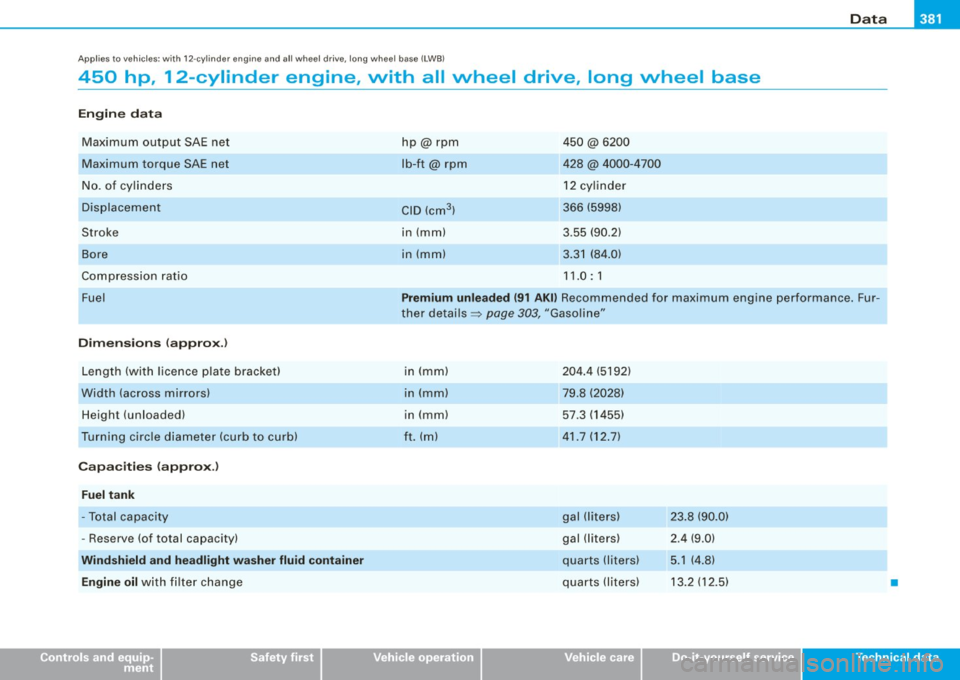
_______________________________________________________ D_ a _ t_a __ lllll
Ap plies to vehic les : w it h 12-c ylinde r en gine a nd a ll whee l dr ive, lo ng wheel base (L WBl
450 hp , 12-cylinder engine , with all wheel drive , long wheel base
Engine data
Maximum ou tput SAE net
M aximum torque SAE net
No . of c ylind ers
D isplac eme nt
Stroke
Bore
Co mpress ion ratio
Fuel
Dimensions (approx .)
Leng th (wi th lice nce plate bracke t)
Width (ac ross m irrors)
Height (unloaded)
Tu rning circle d ia m ete r (cu rb to cu rb)
Capacities (approx .>
Fuel tank
- Tot al capac ity
- Reserve (of total capacity)
Windshield and headlight washer fluid container Engine oil wit h filter ch ange hp@rpm
lb-ft@ rpm
CID (c
m
3
)
in (mm)
in (m m) 45
0@ 6200
428 @ 4000-47 00
1 2 cy linde r
366 (5998)
3 .55 (90.2)
3 .3 1 (84 .0)
11. 0: 1
Premium unleaded 191 AKO Recommended for maximum engine performance . Fur
t her details =>
pa ge 303, "Ga soli ne"
in ( mm)
i n (mm)
in (mm)
f t. Im ) 20
4.4 (519 2)
79.8 (2028)
57.3 (1 455)
4 1.7 (12 .7)
gal (liter s)
gal (liters)
qua rts (liters)
qua rts (liters) 2
3 .8 (90 .0)
2. 4 (9 .0)
5.1 ( 4.8)
13 .2 (12. 5)
•
Controls and equip
ment Safety first Vehicle operation
Vehicle care Do-it-yourself service Tec hn ica l da ta
Page 397 of 408
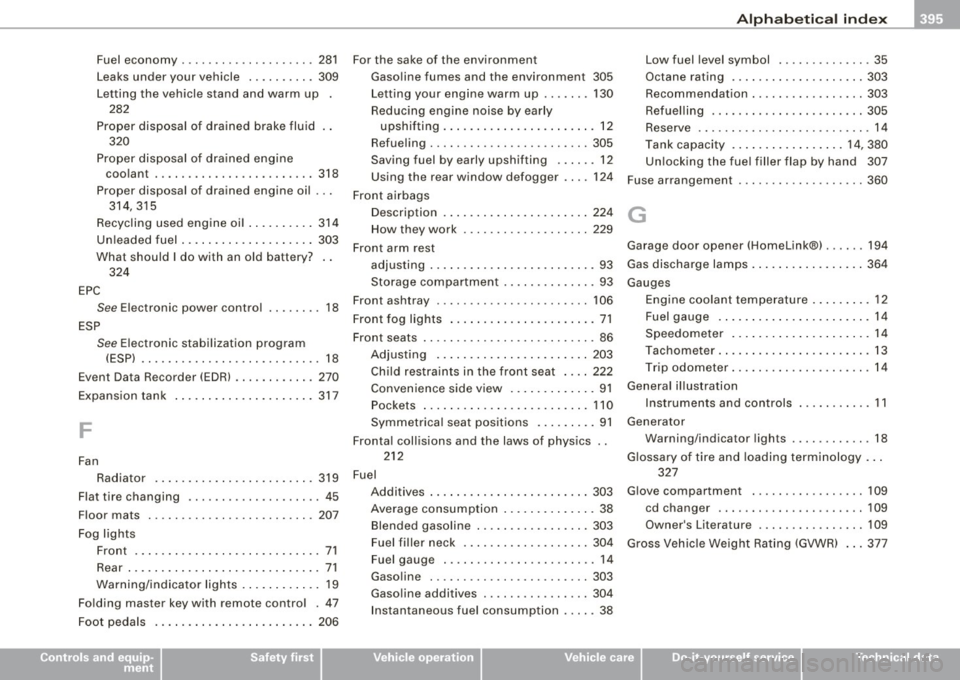
______________________________________________ A_ l_,_ p _h_ a_ b_e _t_i c_ a _ l _in _ d_e _ x __ _
Fuel economy ...... .... .... .... .. 281
Leaks under your vehicle ... .. .... . 309
Lettin g the vehicle s tand and warm up .
28 2
Pr oper disposal of drained brake fluid
320
Proper disposal of dra ined e ngine
coolant ........................ 318
Proper disposal of drained engine oil ...
314,3 15
Recycling used engine oi l ........ .. 314
Un leaded fuel ... .. ... .. ...... .... 303
What should I do with an old battery? 324
EPC
See Electronic power control ........ 18
ESP
See Electronic stabilization program
(ESP) ... ..... ......... ....... ... 18
Event Data Recorder (EDR) ... .... ..... 270
Expans ion tank ...... ... .. ........ .. 317
F
Fan
Radia tor .. ...... ........ ..... .. . 319
Flat tire changing .................... 45
Floor mats ..... .... .... .... ... .... . 207
Fog lights Front .. ... .. .... .... .... ...... ... 71
Rear .... ... .. ....... .. ....... ... . 71
Warning/indicator lights ...... .... .. 19
Fo lding master key with remote control . 47
Foot pedals ... ... .. .... .... .... .... 206
Controls and equip
ment Safety first
For the sake of the environment
Gaso line fumes and the environment 305
L etting your engine warm up .. .... . 130
Reducing engine noise by ear ly
upshifting . ...... .... .... ... .... . 12
Refueling . .... ... .... .... .... .... 305
Saving fuel by early upshifting .... .. 12
Using the rear window defogger .... 124
F ront a irbags
Description ... .... .... .... .... ... 224
How they work ................... 229
Front arm rest adjusting ..... ... .... .... .... .... . 93
Storage compartment ... ...... .... . 93
Front ashtray .... ..... .. ..... .... ... 106
Front fog lights ... .. .... .... .... .... . 71
Front seats ...... .... ........ ....... . 86
Adjusting .. ...... .... .... .... ... 203
Ch ild restra ints in the front seat ... . 222
Convenie nce side v iew .. ...... .... . 91
Poc kets ... .. .... .... .... .... .... 1 10
Symmetrica l seat positions . ...... .. 91
Fronta l collisions and the laws of physics
212
Fuel Additives ... .. ..... .. .... .... .... 303
Average c onsumption .... ...... ... . 38
Blended gasoline ... .. .... .... .... 303
F uel filler neck . ...... .... .... .... 304
Fuel gauge .. ....... .... .... .... .. 14
Gasoline ...... ... .... .... .... ... 303
Gaso line additives ................ 304
I nstantaneous fuel consumption ..... 38 Low
fuel level symbol .... ... .. ..... 35
Octane rating .... .... .... .... .... 303
Recommendation . .... .... .... .... 303
Refuelling . ... .... .... ...... ..... 305
Reserve .......................... 14
Tank capacity .. ...... .... .... . 14, 380
Un lock ing the fue l filler flap by hand 307
Fuse arrangement ... ....... ... .. .... 360
G
Garage door opener (Homelink®) ...... 194
Gas discharge lamps ...... .... .... ... 364
Gauges Engine coolant temperature . ...... .. 12
Fuel gauge ... .... .... ... .... .... . 14
Speedomete r ..... .... ... .... ..... 1 4
Tac hometer . ... ... .... ... .... .... . 13
Trip odometer ... .. .... .... ...... .. 14
General illustration Instruments and controls ......... .. 11
Generator Warning/indicator lights .... .... .... 18
G lossary of t ire and loading terminology . . .
327
G love compartment .. ....... .... .... 109
cd changer ... .... .... .... .... ... 109
Owner's Literature .... .... .... .... 109
Gross Vehic le Weight Ra ting (GVWR) ... 377
Vehicle operation Vehicle care Do-it-yourself service Technical data
Page 402 of 408

___ A---" lp_h_ a_b_ e_ t_ i_ c _ a_ l_ in_d_ e_x ______________________________________________ _
Safety guidelines
Seat adjustment . . . . . . . . . . . . . . . . . . 86
Safety instructions Engine compartment ..... .... .... 309
for a booster seat . . . . . . . . . . . . . . . . 253
for side curtain airbags .... ....... 243
for using a conver tible child safety sea t .
251
for using an infant seat .. ......... 250
for using child safety seats ........ 248
forusingsafetybe lts ... ... .... ... 214
Monitoring the Advanced Airbag System 233
Safety lock Ignition key, automatic transmission 130
Seat adjustment Adjusting the seatback ............. 89
Driver 's seat . . . . . . . . . . . . . . . . . . . . . . 86
Driver's seat memory . . . . . . . . . . . . . . 94
Fron t passenger's seat . . . . . . . . . . . . . 87
Front seats . . . . . . . . . . . . . . . . . . . . . . . 86
Head restraints ............. .. 91,205
Lumbar support .. ............... . 90
Power seat . . . . . . . . . . . . . . . . . . . . . . . 87
Safety guidelines .. ... .... ..... ... 86
Seat belts Why YOU MUST wear them ..... ... 211
Seat memory . . . . . . . . . . . . . . . . . . . . . . . . 94
Seat position Incorrect seat position . . . . . . . . . . . . 205
Seating capacity . .... .... .... ... .... 211 Seating position
Driver . ... .... ...... ...... ...... 202
Front passenger .. .... .... .... ... 203
How to adjust the front seats .. .... 203
Occupants .... .... .... ... ....... 202
Rear passengers
Seats Number of seats 204
211
Selective unlock feature .... ....... ... 52
Selector lever . . . . . . . . . . . . . . . . . . . . . . 167
Service and disposal Safety b elt pret ensioner . ... .... ... 219
Service interval display . . . . . . . . . . . . . . . 27
Service position Windshield wipers . .... .... ....... 82
Servotronic Power steering ...... ...... .... ..
2 7 5
Shift buttons . . . . . . . . . . . . . . . . . . . . . . . 171
Ship Transporting your vehicle . ........ 371
Side airbags Description .... .... .... .... .... .. 239
How they work . . . . . . . . . . . . . . . . . . . 240
Side assist Activating and deactivating ........ 156
Description .......... ...... .... .. 156
Informationa l and alert stage signals 158
Messages in instrument cluster display .. 163
MMI settings ............ .. .. .... 162
Operation . . . . . . . . . . . . . . . . . . . . . . . 158
Safety tips . . . . . . . . . . . . . . . . . . . . . . 164
Sensor detection area . . . . . . . . . . . . 158 Side curtain airbags .
... .. .... .... .. . 242
Description ..... ... .... .... .... .. 242
How they work . . . . . . . . . . . . . . . . . . . 243
Safety instructions . ... .... .... ... 243
Side marker lights .. ....... .... .... ... 69
Sk i sack . . . . . . . . . . . . . . . . . . . . . . . . . . . 102
Snow chains ....... .... ....... .. ... 344
Sockets ........................ 107, 108
Solar blower fan/solar roof . .... ..... . 123
Sound system display Driver information disp lay . .... .... . 25
Spare wheel . . . . . . . . . . . . . . . . . . . . . . . . 352
Speed control sys tem
See Adaptive Cruise Control ...... .. 139
Speed rating letter code .. .... .... ... 340
Speed warning system ........ .... .. . . 37
Speedometer .. .... .... ... ...... ..... 14
Sport Suspension
See Adaptive Air Suspension . .... .. 188
Starting off with a trailer ... ... .... ... 136
Starting the engine .... .... ... ... 129,130
What should I do if the engine does not
start? ... .... .... .... ...... ... . 130
Steering . .... .... .... .... ... .... ... 128
Adjusting s teering column .. .... ... 128
Easy entry feature . .... .... .... ... 129
Locking the steering ....... ....... 129
Malfunction .. .. .. .... .... .... .. . . 33
Steering wheel heating .... .... ... ... 119
Steps for determining correct load limit 336
Stopping the engine .... ... .... .... .. 131